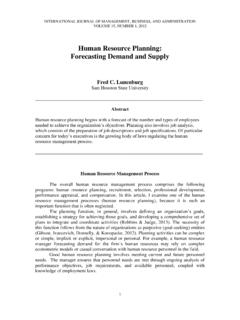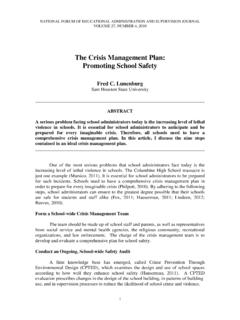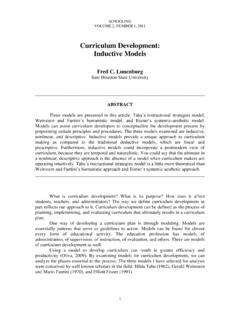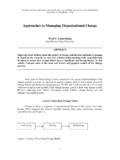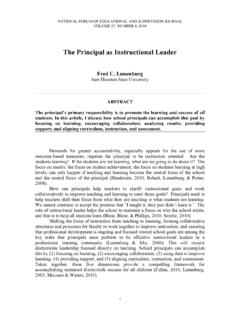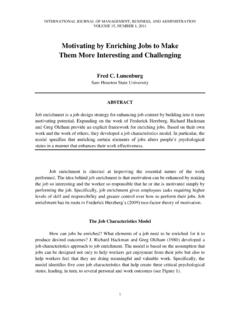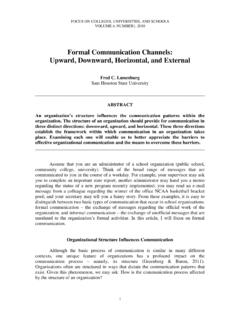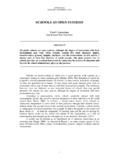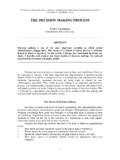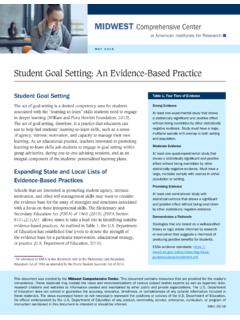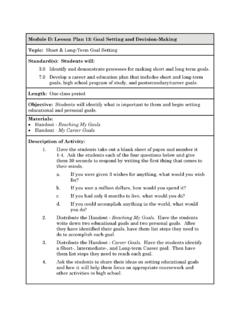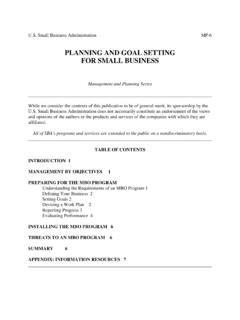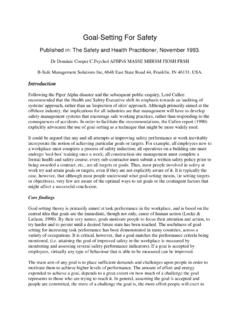Transcription of Goal-Setting Theory of Motivation - National Forum
1 INTERNATIONAL JOURNAL OF MANAGEMENT, BUSINESS, AND ADMINISTRATION VOLUME 15, NUMBER 1, 2011 1 Goal-Setting Theory of Motivation Fred C. Lunenburg Sam Houston State University ABSTRACT Locke and Latham provide a well-developed Goal-Setting Theory of Motivation . The Theory emphasizes the important relationship between goals and performance. Research supports predictions that the most effective performance seems to result when goals are specific and challenging, when they are used to evaluate performance and linked to feedback on results, and create commitment and acceptance. The motivational impact of goals may be affected by moderators such as ability and self-efficacy. Deadlines improve the effectiveness of goals . A learning goal orientation leads to higher performance than a performance goal orientation, and group Goal-Setting is as important as individual Goal-Setting .
2 goals have a pervasive influence on employee behavior and performance in organizations and management practice (Locke & Latham, 2002). Nearly every modern organization has some form of goal setting in operation. Programs such as management by objectives (MBO), high-performance work practices (HPWPs), management information systems (MIS), benchmarking, stretch targets, as well as systems thinking and strategic planning, include the development of specific goals . Furthermore, goal setting is the underlying explanation for all major theories of work Motivation whether that be Vroom s (1994) VIE Theory , Maslow s (1970) or Herzberg s (2009) Motivation theories, Bandura s (1986) social cognitive Theory , or operant-based behaviorism (Skinner, 1979).
3 Managers widely accept goal setting as a means to improve and sustain performance (DuBrin, 2012). Based on hundreds of studies, the major finding of goal setting is that individuals who are provided with specific, difficult but attainable goals perform better than those given easy, nonspecific, or no goals at all. At the same time, however, the individuals must have sufficient ability, accept the goals , and receive feedback related to performance (Latham, 2003). INTERNATIONAL JOURNAL OF MANAGEMENT, BUSINESS, AND ADMINISTRATION 2_____ General Model Edwin Locke and Gary Latham (1990), leaders in Goal-Setting Theory and research, have incorporated nearly 400 studies about goals into a Theory of goal setting and task performance.
4 Figure 1 depicts a simplified view of Goal-Setting Theory . According to the Theory , there appear to be two cognitive determinants of behavior: values and intentions ( goals ). A goal is defined simply as what the individual is consciously trying to do. Locke and Latham postulate that the form in which one experiences one s value judgments is emotional. That is, one s values create a desire to do things consistent with them. goals also affect behavior (job performance) through other mechanisms. For Locke and Latham, goals , therefore, direct attention and action. Furthermore, challenging goals mobilize energy, lead to higher effort, and increase persistent effort. goals motivate people to develop strategies that will enable them to perform at the required goal levels.
5 Finally, accomplishing the goal can lead to satisfaction and further Motivation , or frustration and lower Motivation if the goal is not accomplished. Figure 1. General model of Goal-Setting Theory . Implications for Practice Under the right conditions, goal setting can be a powerful technique for motivating organization members. The following are practical suggestions for managers to consider when attempting to use Goal-Setting to enhance Motivation and performance (DuBrin, 2012; Greenberg, 2011; Newstrom, 2011). goals Need to Be Specific Organization members perform at higher levels when asked to meet a specific high-performance goal. Asking organization members to improve, to work harder, or to do your best is not helpful, because that kind of goal does not give them a focused target.
6 Values Emotions and Desires Intentions ( goals ) Directed Attention Mobilized Effort Persistence Strategies Behavior or Performance Outcomes Satisfaction and Further Motivation Frustration and Lower Motivation FRED C. LUNENBURG _____3 Specific goals (often quantified) let organization members know what to reach for and allow them to measure their own progress. Research indicates that specific goals help bring about other desirable organizational goals , such as reducing absenteeism, tardiness, and turnover (Locke & Latham, 2002). goals Must Be Difficult but Attainable A goal that is too easily attained will not bring about the desired increments in performance. The key point is that a goal must be difficult as well as specific for it to raise performance.
7 However, there is a limit to this effect. Although organization members will work hard to reach challenging goals , they will only do so when the goals are within their capability. As goals become too difficult, performance suffers because organization members reject the goals as unreasonable and unattainable. A major factor in attainability of a goal is self-efficacy (Bandura, 1997). This is an internal belief regarding one s job-related capabilities and competencies. If employees have high self-efficacies, they will tend to set higher personal goals under the belief that they are attainable. The first key to successful goal setting is to build and reinforce employees self-efficacy. goals Must Be Accepted goals need to be accepted.
8 Simply assigning goals to organization members may not result in their commitment to those goals , especially if the goal will be difficult to accomplish. A powerful method of obtaining acceptance is to allow organization members to participate in the Goal-Setting process. In other words, participation in the Goal-Setting process tends to enhance goal commitment. Participation helps organization members better understand the goals , ensure that the goals are not unreasonable, and helps them achieve the goal. The factor of self-efficacy mentioned above also may come into play regarding imposed goals . Some individuals may reject imposed goals , but if they have self-efficacy, they may still maintain high personal goals to accomplish the imposed goals (Bandura, 1997).
9 Feedback Must Be Provided on Goal Attainment Feedback helps organization members attain their performance goals . Feedback helps in two important ways. First, it helps people determine how well they are doing. For example, sports teams need to know the score of the game; a sharpshooter needs to see the target; a golfer needs to know his score. The same can be said for a work team, department, or organization. Performance feedback tends to encourage better performance. Second, feedback also helps people determine the nature of the adjustments to their performance that are required to improve. For example, sports teams watch video reproductions of a game and adjust their play; a sharpshooter can adjust his shot; a golfer can adjust her swing; and a CEO of an organization can gage the growth, profitability, and quality of a product line.
10 INTERNATIONAL JOURNAL OF MANAGEMENT, BUSINESS, AND ADMINISTRATION 4_____ goals Are More Effective When They Are Used to Evaluate Performance When employees know that their performance will be evaluated in terms of how well they attained their goals , the impact of goals increases. Salespeople, for example, have weekly and monthly sales goals they are expected to attain. Telephone operators have goals for the number of customers they should assist daily. Quarterbacks are judged on the completion percentages of passes thrown and the number of yards the offense generates per game. Coaches are assessed on their win-loss record. CEOs of organizations such as IBM, General Motors, and Microsoft Corporation are evaluated on meeting growth, profitability, and quality goals .
